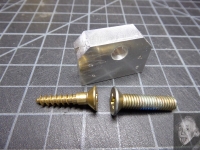There are many different countersink angles. Here is a short list of the more common ones with their included angle in degrees and their usage...
82 - Woodscrews, UNC, UNF, Robertson
90 - metric, BA, BSW, BSF
100 - aircraft fasteners
There may be others as well but those are the only ones I have encountered so far.
Exactly matching the countersink angle to the fastener doesn't matter that much for woodwork since the medium is compressible but, for machine screws, it's important.
I have a lot of difficulty telling an 82 from a 90. In the picture below we have an 82 deg woodscrew on the left and a 90 deg metric machine screw on the right. Even if your vision isn't 3/4 of a century old, you may have difficulty telling the angles apart.
I decided to make myself a gage for distinguishing 82 from 90 fasteners. A small block of aluminum scrap was squared up and V-grooves were carved down the middle two opposing sides using a drill-mill (one of the handier tools in the arsenal). Then one corner of the block was cut off at a 41 deg (half of 82) angle and the other at a 45 deg angle. The former side was stamped 82 and the latter 90 for easy identification.
This picture shows how the gage is employed. Hold the fastener against the gage using the V-groove to orient and stabilize it. Then slide it down until the conical part of the fastener hits the angled portion of the gage. If no light shows through the gage, the fastener requires a countersink of the angle stamped on that side of the gage.
I didn't bother to add a facility for identifying 100 deg fasteners since I don't encounter those often and, when I do, I can generally identify them by sight. If needs must, there are still two unused corners on the gage.


 LinkBack URL
LinkBack URL About LinkBacks
About LinkBacks




 Reply With Quote
Reply With Quote




Bookmarks